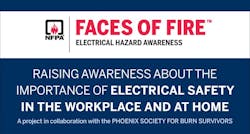NFPA Addresses Arc Flash Events in Faces of Fire Electrical Hazard Awareness Video Series
The National Fire Protection Association (NFPA) and the Phoenix Society for Burn Survivors recently unveiled the final video interview of its Faces of Fire/Electrical series. The video series features personal stories of people impacted by electrical incidents and demonstrates the need for continued education and awareness about electrical hazards in the workplace and at home.
In August 2004, Don Johnson, an electrician from Florida, was at work connecting a client’s backup generator for use during an impending hurricane when a failure of his rotation tester or a loose clip shorted out in a 4,000 amp/480-volt switchgear section he was working on, creating an arc flash event that destroyed much of the equipment and blew him against a wall, nearly killing him. Johnson survived but suffered third-degree burns on his face, neck and arms — and spent years recovering from his injuries.
Since his injury, Johnson has returned to his company as a service manager and continues to advocate for electrical workplace safety.
Arc flash, also known as flashover, is the light and heat produced as part of an arc fault. It’s a type of electrical explosion or discharge that results from an unintended electrical connection through the air to ground or another phase of the electrical system.
An arc flash is one of the most devastating and deadly electrical hazards present in today’s workplace; it can produce temperatures as high as 35,000 ° F and cause severe burns, hearing loss, eye injuries, skin damage from blasts of molten metal, lung damage, and blast injuries. An NFPA report, titled “Occupational Injuries from Electric Shock and Arc Flash Events,” estimates that five to 10 arc flash incidents occur every day. More than 2,000 people are treated annually in burn centers with arc flash injuries.
“Electrical professionals face numerous hazards every day on the job, including shock, electrocution, arc flash, and arc blast, therefore, it is critical that employers and workers take a shared responsibility for safety protection — including the creation and implementation of an electrical safety program,” said Lorraine Carli, NFPA’s vice president of outreach and advocacy. “The Faces of Fire/Electrical campaign reminds us that ignoring even basic safety rules can lead to serious injuries and death.”
Both shock and arc flash, in addition to other electrical hazards, have been the focus of NFPA 70E, Standard for Workplace Electrical Safety and OSHA standards since the late 1970s. NFPA 70E emphasizes the importance of performing a solid risk assessment that examines all aspects of the hazards to which employees are exposed and provides a valuable tool to determine how best to mitigate the potential danger.
Faces of Fire/Electrical features personal stories of electrical burn survivors whose lives have been forever altered and how more understanding, training, and a change in work culture could have significantly impacted these outcomes. Woven into these stories of resilience is an additional interview with a physician dedicated to the complete physical and emotional healing of patients suffering from a burn injury.
A recent NFPA Podcast, “The Mysteries of Electrical Injuries,” features three renowned doctors whose research and work with electrical burn patients helps explain what a powerful shock can do to the body, the treatments available, and how an understanding of these injures is continuing to evolve.
While many electrical injuries prove fatal, those that are not can be particularly debilitating, oftentimes involving complicated recoveries and lasting emotional and physical impact. The Faces of Fire/Electrical campaign ultimately works to help build a safer world by teaching others and supporting the burn survivor community in advancing life-long healing, optimal recovery, and burn and injury prevention.
Visit www.nfpa.org/facesoffire to watch the videos. Free resources are now available to download and share.
